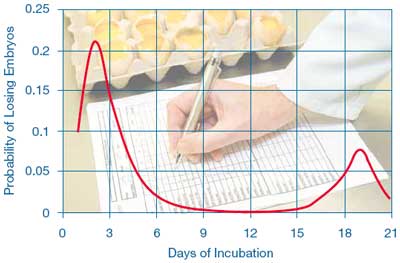



Investigating Hatchery Practice - Introduction
In the first article of this series, the importance of routine quality control in the hatchery and appropriate procedure for doing so are described. It is written by Dr Steve Tullett, consultant for Aviagen specialising in incubation and fertility, and it forms part of a recently published Ross Tech publication.To achieve good hatchability and chick quality, fertile eggs need careful management from the time they are laid. Environmental conditions during egg collection, egg shell disinfection, transport, pre-storage incubation, storage, pre-warming or during incubation are all important. Inappropriate treatment can result in depressed hatchability, change the pattern of embryo mortality and may also affect post-hatching performance.

The investigative procedures described in this Ross Tech can be used in the routine quality control programme in the hatchery to benchmark hatchability levels and the nature of embryo losses against accepted best practice standards. Other information is provided that may be useful when troubleshooting hatchery problems.
Routine Quality Control in the Hatchery
Not all fertile eggs hatch. Even eggs from flocks which are hatching well follow a predictable embryonic mortality pattern. Mortality is usually higher in the first few days of incubation when all the organ systems are forming in the embryo. The middle period of incubation is essentially a period of rapid growth and is usually characterised by very few embryo deaths. Mortality rises again in the last few days of incubation when the embryos turn towards the air cell in order to ventilate their lungs, redirect their blood circulation, retract their yolk sacs and finally attempt to hatch. Figure 1 shows a normal pattern of mortality in a flock which is hatching well.
Gathering data on fertility, hatchability and the time and nature of embryo losses relative to flock age is an important part of the routine quality control programme in any hatchery. Hatchery workers should be trained to gather the relevant data. They need to know how to recognise infertility and egg contamination, and to identify the stage of development reached by embryos that failed to hatch. They also need to recognise embryonic malformations and malpositions.

Based on Kuurman et al. (2003). Poultry Science, 82:214–222
Accurate data allows hatchery performance to be compared against best practice standards and provides the baseline for investigating hatchability problems when they arise. By establishing where deviations from the normal pattern of embryonic mortalities are occurring, it is usually possible to identify where the problem lies. For example:
- Losses in the first week of incubation tend to be due to problems arising before incubation, i.e. on farm, in transport or in storage.
- Losses in the second week of incubation are most likely to arise from contamination or faults in nutrition, although occasionally inappropriate setter conditions may be involved.
- Losses in the final week of incubation are usually associated with inappropriate incubator conditions.
Procedures for Monitoring Hatchery Performance
Procedures and skills that can be used in routine hatchery quality control, when carrying out a hatchery investigation and when troubleshooting hatchability problems include:
- Assessing fertility
- breaking out fresh unincubated eggs
- breaking out partially incubated eggs
- breaking out incubator 'clears'
- Examining the hatch debris
- recognising developmental stages and malformations
- recognising the normal hatching position and malpositions
- recognising egg contamination
- Monitoring weight loss during incubation
- egg weight loss to 18 days
- chick yield
- Monitoring temperatures
- monitoring the temperature exposure profiles of eggs
- measuring eggshell temperatures during incubation
- Monitoring the hatch window
The whole of this Ross Tech publication will be serialised on ThePoultrySite over the coming weeks.
Further Reading
| - | You can see other articles in this series Investigating Hatchery Practice by clicking here. |
December 2009









